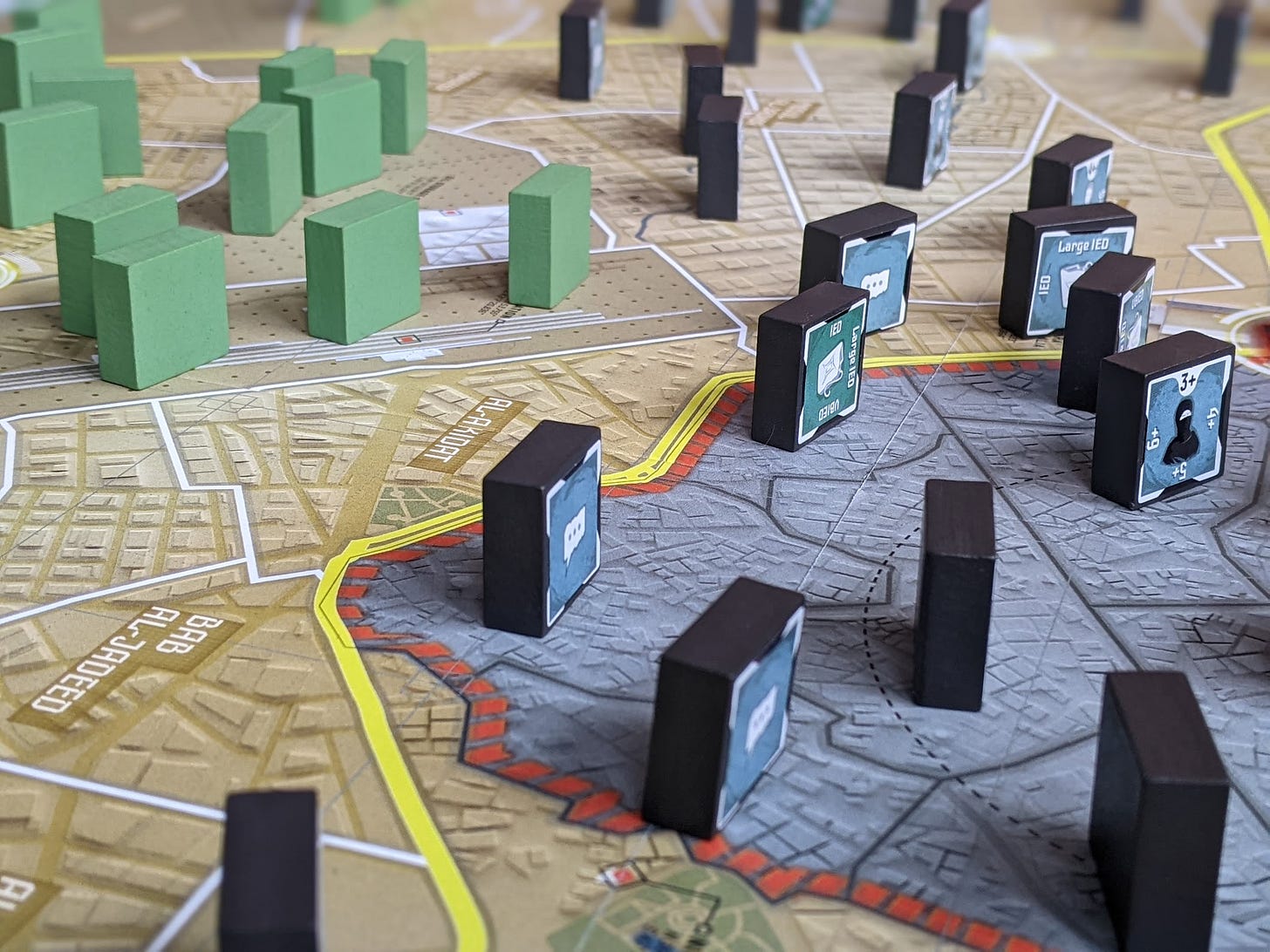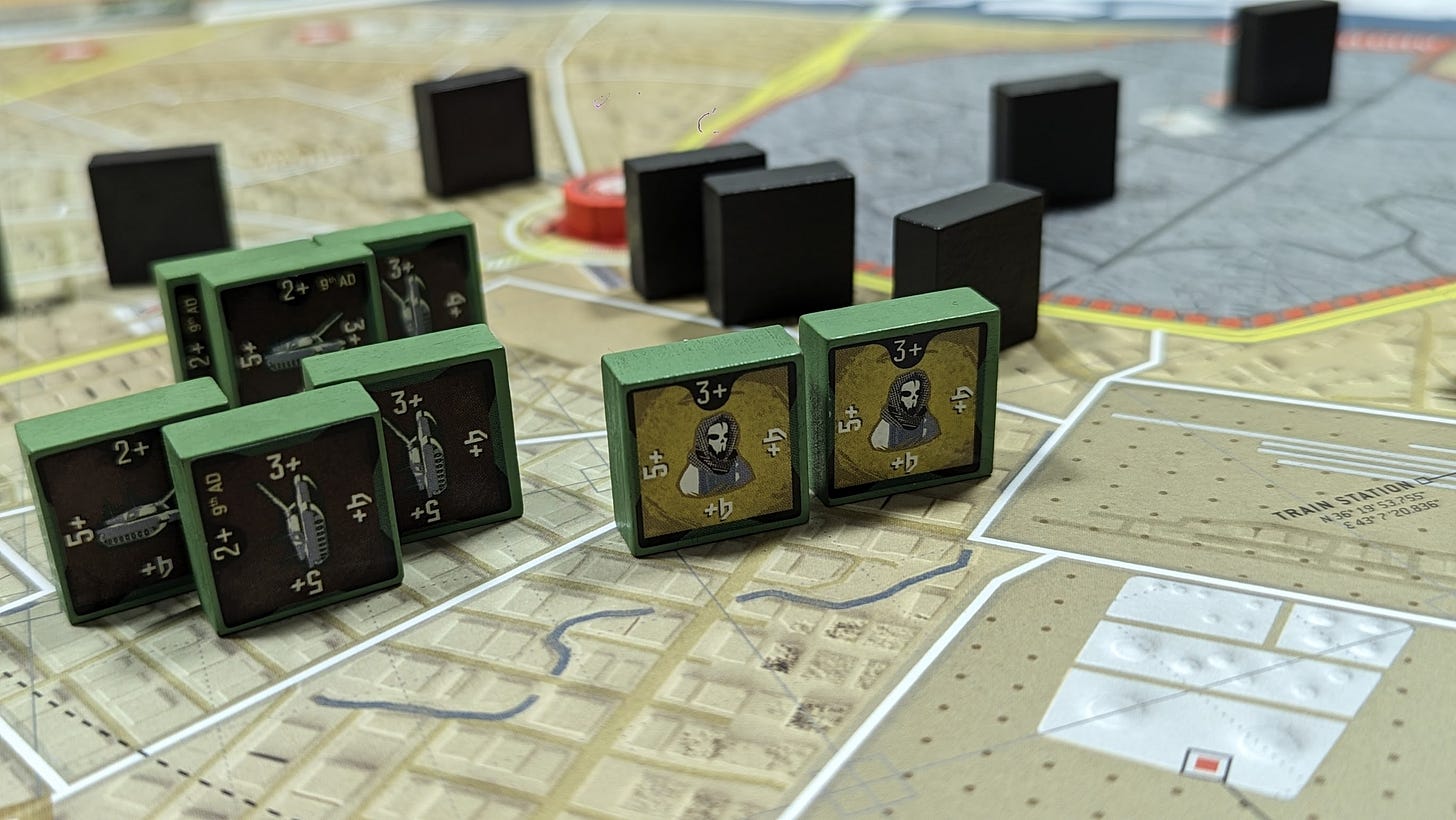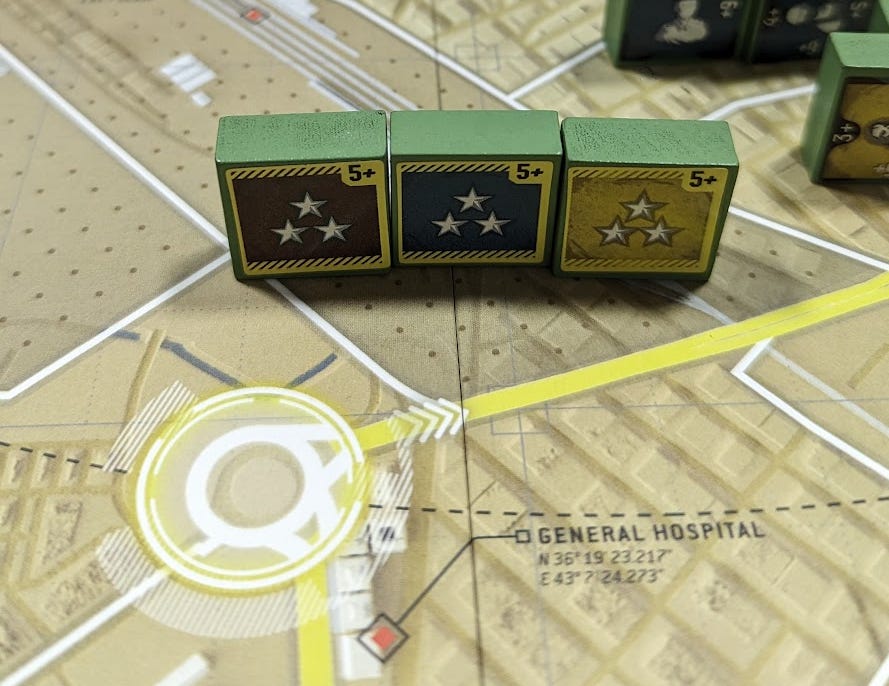Retaking Nineveh
A review and discussion of educational use of We Are Coming, Nineveh, designed by by Harrison Brewer, Juliette Le Ménahèze, Rex Brynen, Brian Train and released by Nuts! Publishing
Urban environments are crucial in modern warfare and will remain so in the foreseeable future. Therefore, the analysis of urban operations is among the key functions of conflict simulations in professional and educational environments. An interesting example intersecting the educational and hobby wargaming is We Are Coming, Nineveh, a game designed and developed by Harrison Brewer, Juliette Le Ménahèze, Rex Brynen, Brian Train, and published by Nuts! Publishing. Here, I provide my impressions of it as a game along some considerations on how it can be used educationally. In future posts, I will try to stress educational aspects of games I review, especially those that I used or plan to use in classes.
The game portrays the final stages of the Battle of Mosul (2016-2017), when the Iraqi security forces (ISF) close in on the Old Town of Mosul, where Daesh intends to take their last stand. We Are Coming, Nineveh takes the form of a block game with its inclusion of the fog of war and the classic gradual rotation of blocks once units get hit. This rotation also lowers the effectiveness of the unit, requiring increasingly higher rolls to hit the enemy. Yet, a lot modifications are put on the classical framework to make the game tell a story of urban warfare and the story of the Battle of Mosul.
We Are Coming, Nineveh being a block game means that there is no shortage of dice rolling. This may put off some players as being too luck-based (especially if you consider random event cards that are drawn when a 1 or a 6 is rolled during the combat phase). My view of luck in games is that if it is justified thematically and/or players have some control over the probabilities, simulationist games should have this element. For a game depicting urban warfare it must be at the core of the mechanics. You can’t plan for everything and battle friction coming through cards (such as losing forward observer capability) helps to reveal the uncertainties of urban warfare and challenges to planning. The player also has control over luck by moving units or for the ISF having an operational pause (losing time but using it to regroup and recover). This brings one of the key simulationist elements of the game that simply emerges from the mechanics – the need to rotate your forces. Whether you are moving ISF units into the Old City or defending Daesh positions, you face attrition and need to constantly move out units that lost efficiency (due to stacking rules) and move in units that are still somewhat more capable to fight.
The dynamics of the game are quite clearly set. The ISF player has to push to the Old City of Mosul and take it from Daesh control. Therefore, one player will be consistently on the offensive while the other will have to retreat towards the Old City. This is dictated by the historical situation so it couldn’t be different in the game. However, how the push/ retreat works out it is not that straightforward ad varies from game to game. One reason for it is the inclusion of major roads in the game space. Blocking them is important for Daesh, as controlling roads gives ISF fast movement to nearly everywhere. Thus, selecting strategic defence positions as well as quick counterstrikes must be considered to slow down the government forces.
The flow of the game is also affected by one of its most brilliant additions – a trilemma of time, casualties, and collateral damage. While the player dynamics remain largely similar, these three aspects provide the needed variation. The longer it takes, the more casualties ISF suffers, and the more collateral damager there is, the more Daesh achieves, even if the ‘lose’ in the expected sense of the word. At the start of the game each players select their priority. Daesh – the target to maximize, ISF – the target to minimize. Inclusion of collateral damage is especially important. Civilian population took a terrible toll during the battle, and leaving it outside the scope of the game (which, alas done in many cases) would have been improper.
I’ve seen comments that collateral damage is especially difficult to control for, as a lot of it can come from event cards. While this is true, it is not completely out of the ISF player’s hand due to the capabilities they can choose at the start of the game. Will they rely on artillery and air support (which in an urban environment is quite likely to cause civilian casualties)? Or will they enforce stricter rules of engagement among their troops and reduce the likelihood of harming civilians? Similarly, Daesh player can opt to use human shields and similar strategies to achieve the opposite. The capability selection is a great addition to the game, as it helps select a specific strategy for the game that the opponent may not be expecting. Snipers, observers, unmanned aerial vehicles, different types of IEDs… They all help to highlight the different faces of a modern urban battle. Finally, the addition of rumours really enhances the fog of war already generated . They also fit well thematically and might slow down the approach of ISF, only to find that there were not actual enemy at specific locations.
Coming back to the trilemma, it relates to one other important aspect of We Are Coming, Nineveh – its narrative. The game provides two ways of determining the final outcome. One is to calculate victory points based on time that passed in the game, casualties suffered by the ISF, and damage inflicted on civilians. The higher the numbers, the better it is for Daesh. This frames victory in a standard wargame view – a specific number victory points have been scored, so one of the sides achieves a (major) victory. The other way to look at the final outcome is through the narrative that is based on time, ISF casualties, and collateral damage.
Visually, the game is attractive, while not losing out on the informativeness of the board, the blocks or the cards. The map is clear to read and immersive with specific places highlighted and coordinates indicated. Even if only for flavour reasons, it makes the map compelling. Capability cards clearly indicate when they can be used and how, who makes decision on the distribution of the effects, etc. So, the visuals score high in my book.
As the tone and content of this review shows, I really enjoy the game, but it may not be for everyone. So, who will (not) like the game? If you are fine with the overall mechanics of block games, then the game would be a good addition to the collection, including even if you already have numerous block games. We Are Coming, Nineveh is sufficiently unique to become an integral part of such collection. If you are interested in modern urban combat then the game can also help understand it better. On the other hand, if you are weary of luck-based elements or the overall structure of the game, where one side is consistently on the attack while the other on the defense and is pushed toward a particular map space, it may not be for you. Yet, both of these elements fit well thematically.
Teaching with We Are Coming, Nineveh
We Are Coming, Nineveh is a game I have already used in classes and I certainly plan on doing so. It is not at all surprising that the game originates from the course given by prof. Brynen at McGill University, where it started as a project by then students Harrison Brewer and Juliette Le Ménahèze. So, in what ways can it be helpful in the educational environment?
Teaching about urban warfare. The game portrays a modern urban battle and playing it helps to immerse participants into its workings. On the one hand, it helps identify the key challenges related to fighting in cities (attrition, collateral damage, uncertainties, friction, different spaces, etc.). On the other hand, it also asks important questions about the goals of an urban operation. This may serve as a good point for a discussion between students on how to interpret the aims based on the given trilemma (time vs. casualties vs. collateral damage) and how these elements interact. Focusing on the narrative outcomes instead of victory points can further ignite the discussion by asking the meaning behind the final situation. After all, you don’t get victory points in an actual fight, but rather a particular situation. This may lead to a broader discussion on interpreting the flow and outcomes of urban operations, as well as what is acceptable in terms of the horns of the trilemma.
Modelling. From the perspective of courses on wargaming as a method, my key teaching objectives when using We Are Coming, Nineveh would focus on:
Incorporating randomness and uncertainty in simulation-focused games, how they are modelled, why, etc. Here, the post-game discussion can focus on player agency and control of luck-elements, as well as fog of war and the role that rumours can play in games.
Asking players to make difficult decisions. The trilemma structure of We Are Coming, Nineveh, is a good way of demonstrating how each choice can have both benefits and drawbacks. Post-game discussion can explore how players are made to choose and what reasoning they go through (based on students’ own experiences of playing the game).
Building a certain flow of the game (i.e. ISF always pushes Daeash to the Old City) while leaving enough room for variation to not tell the same story over and over and leaving room for exploring different strategies.
Using event cards to add details to the game not only through their mechanical effect but also through text narrative, explaining these mechanical effect. The discussion could focus on the importance of story-telling through adding minor snippets of text on what is happening thematically.
Defining the meaning of victory. Daesh cannot win the fight in a traditional sense of the word – they cannot retake Mosul and reestablish their rule. Instead, the game (whether through narrative or through victory points) interprets victory through the perspective the horns of the trilemma it’s built upon.
Ethics. Wargaming a kinetic conflict, especially such a recent one leads questions on ethics and the design notes for We Are Coming, Nineveh address it directly. Therefore, the post-game discussion should include questions about the ethics of wargaming more generally as well as specifically about the role that inclusion of collateral damage adds to the game. Finally, the players should discuss how their role and the options they had in-game reflected their decisions (for example, to use or not to use ISF artillery support in the Old City due to higher risk of collateral damage).
Suitability for the classroom environment. The game can be played relatively quickly (two hours is possible), but a full game with rules explanation would likely last longer than a standard class/seminar (here, in Lithuania usually three full hours), especially, if participants are new to block games. In addition to the rules, explaining some thematic design decisions could also be useful (or giving design notes to read before the lecture), if the game is used in a civilian environment. Therefore, sufficient time should be given whether by agreeing with students to continue after the official class time or organizing the game session in a club or other non-class environment. Once the rules are clarified and a couple of turns done, the game should progress quite quickly, though due to many points that could lead to discussion, the post-game part may also last quite a bit. Thus, there are some challenges that need addressing by the instructor when preparing. On the other hand, We Are Coming, Nineveh shows how a single game can be used to teach numerous things from wargaming as a method, to urban warfare concepts, to ethics. And here lies its greatest educational value.
I would advise to use the starting scenario cards and prepare in advance on related discussion points (e.g. the role of rumours in urban warfare, the use of air and artillery support in an urban environment). Another advise for classroom use would be to focus on the narrative result rather than victory points. This would help reduce the potential negative reaction to the game by the losing side, as narratives are more open to interpretation rather than a quantitative value given by calculating victory points.
Type of classes. I have used We Are Coming, Nineveh in a class on wargaming as a method and it works for that purpose due to the broad range of learning topics it brings. The game would also be highly relevant for classes on urban warfare, military history, and even history of the 21st century as a case study.







